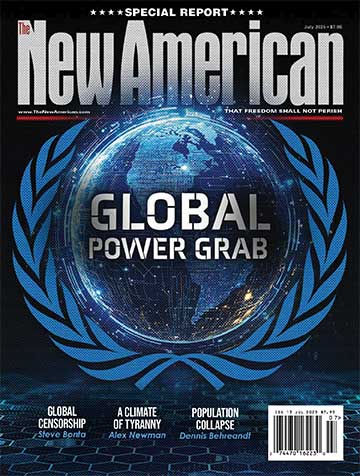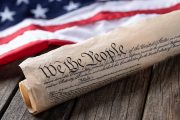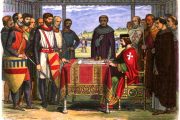Although record-keeping was a vital part of James Madison’s participation at the Constitutional Convention, it was not his primary contribution. He was there as the drafter of the Virginia Plan and as a man convinced that his country needed a stronger central government if the union was to be preserved. Thus, as the days, weeks, and months wore on, the articles of that plan became the primary points of debate among the representatives.
It was not, however, the only plan offered for the convention’s consideration. Delegates from the small states feared that Madison’s Virginia Plan granted too much influence in the proposed central government to the large states such as Virginia. Specifically, small-state delegates averred that the provision of the Virginia Plan that apportioned representation in the proposed legislative branch according to population would give substantial — even unstoppable — sway to the states with greater numbers of inhabitants.
Fearful, then, of the prospect of being consigned to a second-class category of membership in the new general government, on Friday, June 15, 1787, New Jersey delegate William Paterson offered a competing plan of government, one that preserved the equality of states that existed under the constitution then in effect: the Articles of Confederation.
Before examining the particulars of Paterson’s plan — known most commonly as the New Jersey Plan — here’s a brief biographical sketch of Paterson, penned by fellow delegate William Pierce in his “Character Sketches of Delegates to the Federal Convention:”
M. Patterson [sic] is one of those kind of Men whose powers break in upon you, and create wonder and astonishment. He is a Man of great modesty, with looks that bespeak talents of no great extent, — but he is a Classic, a Lawyer, and an Orator; — and of a disposition so favorable to his advancement that every one seemed ready to exalt him with their praises. He is very happy in the choice of time and manner of engaging in a debate, and never speaks but when he understands his subject well. This Gentleman is about 34 years of age, of a very low stature.
As for Paterson’s plan, it was presented to the convention as an alternative to the Virginia Plan. Although the exact authorship of the plan offered by Paterson is unknown, scholars have named Paterson, Roger Sherman, and Luther Martin as likely co-authors, or at least its primary architects.
The first section of the plan lays out succinctly its theory and immediately distinguishes itself from Madison’s Virginia Plan:
Resolved, that the Articles of Confederation ought to be so revised, corrected, and enlarged as to render the federal Constitution adequate to the exigencies of government and the preservation of the union.
The language of that introductory paragraph would have been familiar to every delegate present that day, as it copied the text of the resolution of Congress passed on February 21 of that year, the resolution establishing the limits of the authority of the convention:
Resolved that in the opinion of Congress it is expedient that on the second Monday in May next a Convention of delegates who shall have been appointed by the several states be held at Philadelphia for the sole and express purpose of revising the Articles of Confederation and reporting to Congress and the several legislatures such alterations and provisions therein as shall when agreed to in Congress and confirmed by the states render the federal constitution adequate to the exigencies of Government & the preservation of the Union.
Regardless of its ultimate failure to be approved by the representatives of the 12 states present the day Paterson proposed his plan, he is to be congratulated for having the integrity to confine himself to within the boundaries of his authority as delineated by Congress and his own state’s legislature.
Within the Paterson plan, Congress was granted more expansive authority than it possessed under the Articles of Confederation, including the power to levy import duties and stamp taxes, “to be applied to such federal purposes as they shall deem proper and expedient.” Additionally, the plan authorized Congress to pass acts to direct the collection of requisitions made by it to the states, if states did not comply with those requisitions. Notably, however, none of the powers proposed to be granted to Congress in Paterson’s plan could be exercised without the approval of a specified number of states.
Beyond that measured expansion of the powers of Congress, the Paterson plan’s only other noteworthy alterations to the Articles of Confederation were the creation of an executive consisting of several people elected by Congress and removable by Congress upon receipt of an application submitted by a majority of the state governors; and the establishment of a judiciary body to be appointed by the executive committee.
Max Farrand, author of The Framing of the Constitution of the United States, made the following observation regarding Paterson’s New Jersey Plan and the unfortunate timing of its being brought to the attention of the delegates:
It would seem as if the New Jersey plan more nearly represented what most of the delegates supposed that they were sent to do…. But in the course of the two weeks’ discussions [since the introduction on May 29 of the Virginia Plan], many of the delegates had become accustomed to what might well have appeared to them at the outset as somewhat radical ideas.
Regardless of what might have been, the state delegates favoring the Virginia Plan and those supporting the New Jersey Plan would begin the next day — June 16, 1787 — to begin the battle to craft a constitution that would save the union and preserve the recently hard-won independence of the American states.
This is article six in our summer series on the 1787 Constitutional Convention.




